October/November 2013
Que Bella Giornata!
Beautiful mornings in our own private Italy
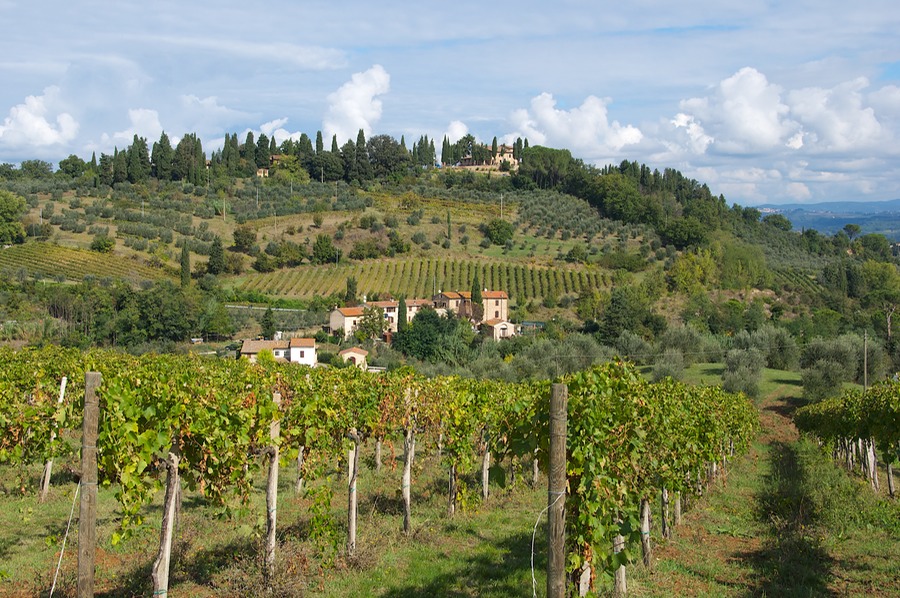
Well, Italy just plain old takes the cake and we continue to be enjoying ourselves as we travel around the lovely countryside. We’ve definitely had our ups and downs this fall, and have had to come to grips with our frustration with and irritation at some of what passes for “doing business” around here. However, our travel plans include both this fall and next spring in the land of pizzas and piazzas, and it’s a good thing we’ve allowed plenty of time.
We closed our last letter while we were in Tuscany. Beautiful region, just as lovely as advertised. Everybody wants to go to Tuscany, and of course they do. By the thousands. Doesn’t seem to be any quiet time. We enjoyed several days south of Florence, the biggest draw in the region; it was lovely in Greve in Chianti, where we spent time with friends (and even did the laundry – 21€ for 3 loads). When they left to go on to Florence, we decided we’d rather start by exploring a bit of the area around there first; perhaps just a slight feeling of delaying the inevitable, but we couldn’t quite motivate ourselves for another major city visit quite yet.
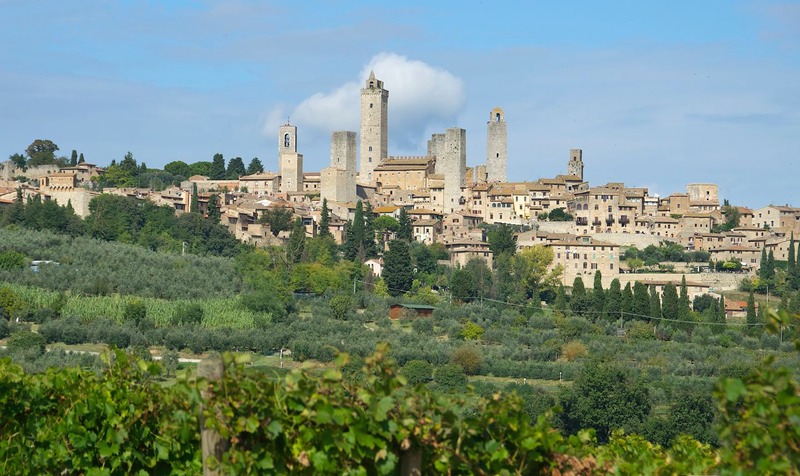
We started with San Gimignano, a historic city we’d become acquainted with through the movie Tea with Mussolini. If you’re familiar with that piece of World War II cinema, you may remember Judy Dench hysterically hugging and refusing to leave off trying to protect a gorgeous painting in one of the churches, as the Germans were threatening to blow everything up before being forced to leave by the approaching Americans. We found that painting, in the Duomo (the cathedral), and I wanted to hug it too. It’s lovely. The city is quite charming, even with only fifteen of its original 72 medieval towers still intact, and very popular. We timed our visit for around the lunch hour and had a nice time wandering around in the rain. As we were leaving, the afternoon tour busses were just arriving so we allowed ourselves to feel just a bit smug.
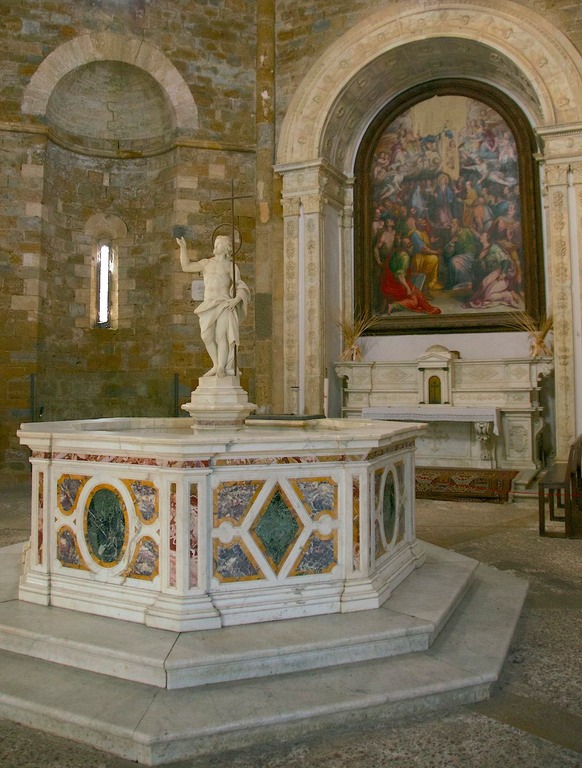
From there we drove on to Volterra, highly recommended by friends as being a very nice medieval town with a great Etruscan museum. True on both counts. It was even better than San Gimignano and a lot less crowded. To get to the old center you must climb a zillion stairs up into the hilltop city so you knew you’d earned it when you got to the top. I must say that medieval hill towns are absolutely super. Winding little streets and alleys, tall buildings looming over you, doors that appear ready to fall apart at your touch they’ve been there so long, tiny piazzettas with little fountains; totally cool and very atmospheric. By now we’ve probably seen a dozen or more, each one delightful and different. I love them all.
The Etruscan museum was very interesting and informative. The Etruscans predated the Romans here in Italy, and are important because they were a very well developed society that created very sophisticated art and lasted for a considerable time (over 800 years, ending in 88 BC. Oh, and our alphabet is based on what they created. Cool dudes.) I remembered them well from my art history classes, and have greeted them as old friends wherever the opportunity arises. We will be seeing more of them, I am sure. The museum is located in an interesting old building that was great to wander through, adding even more to the experience.
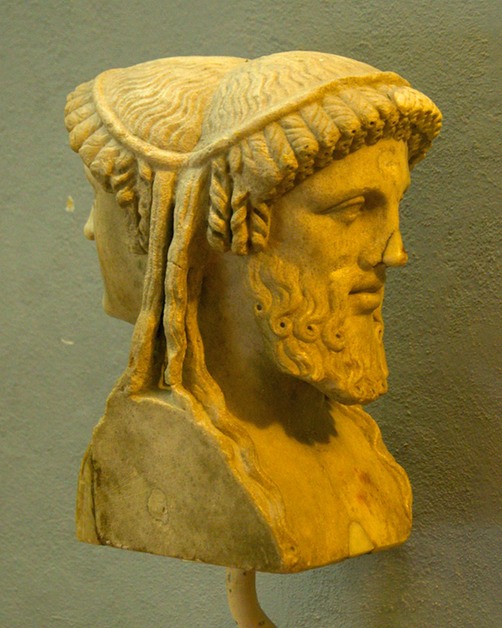
While in Volterra we also stopped in at the Pinacoteca, filled with splendid paintings. Interestingly, they had interspersed the Renaissance, etc. stuff with some very different and striking modern works by an Italian artist named Andrea Granchi. Unusually, they all fit together very well, and we enjoyed the juxtaposition. We liked Volterra a lot; I’d never heard of the town, but we were really glad we’d visited.
Oh, and Volterra has a Museum of Torture. Neither the first nor the last town we’ve visited that had such an attraction. Why? What’s the big deal??? Apparently they are a popular tourist draw, but once again we found the will to resist.
We had one other spot in mind that we wanted to visit in this area, although we sort of groaned as we thought about it: Pisa and Himself, the Great LT (leaning tower, of course). So we dropped down out of the hill towns and headed for the Mediterranean. Pisa used to be on the coast, until the port silted up (a common occurrence in this neck of the woods). But it’s still close to the shores, on an open plain with aqueducts aplenty carrying water around.
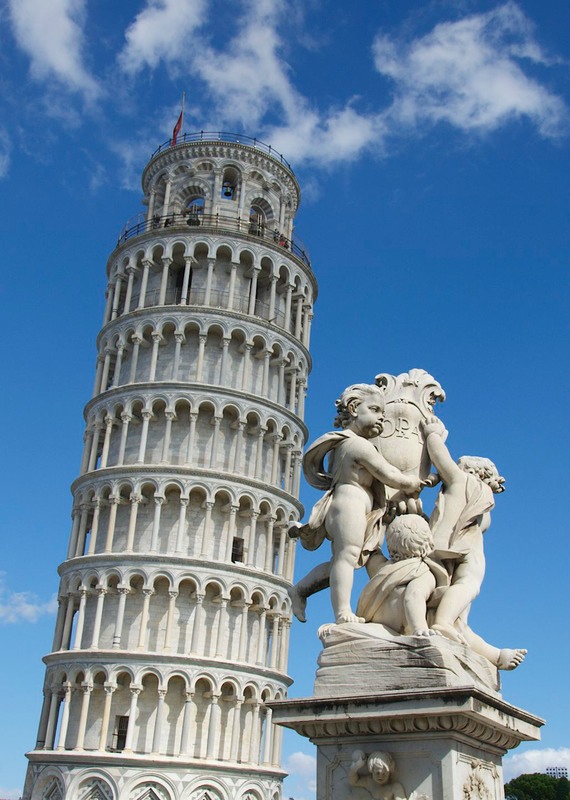
We arrived with trepidation, but our concerns proved to be unfounded and we had a splendid visit. Pisa is a surprisingly nice city, and very pleasant to wander around in. We spent a lot of time in the area around the Tower, though we were not tempted to pay the (we thought) exorbitant fee to clamber up inside. The tower is amazingly beautiful and covered with intricate, detailed carvings on the exterior -- a real pleasure to study; and it really does lean a lot! We’d already seen several towers in other cities that were kind of vertically challenged, but not like this one… truly the King of the Leaning Towers. Best of all is that the tower, along with the Duomo and the Baptistry, are grouped together in a lovely grassy area, absent the usual medieval clutter that so often make it difficult to really appreciate fine old buildings. All three buildings are shining white alabaster, it was a lovely day, and the pictures are incredible. The Baptistry had a special charm. The acoustics inside are amazing, and one of the security guards is clearly chosen for the position due to his rich baritone voice. He demonstrated the wonderful sound by producing perfect harmonics as he sang several tones at differing pitches and let the rich sound reverberate around the inside of the building. Wow! And the Duomo is one of the most beautiful we’ve seen.
There are several other museums in town as well; they all looked quite intriguing, but we’d done ourselves in by walking from the sosta into the old town (45 minutes); we should have taken the bus!!! We think Pisa was a great place to see, very atmospheric and a good place for wandering; we walked alongside the Arno River, which was coming from Florence and making its way to the sea. Regardless of any preconceptions you might have of Pisa, don’t even think of missing it!
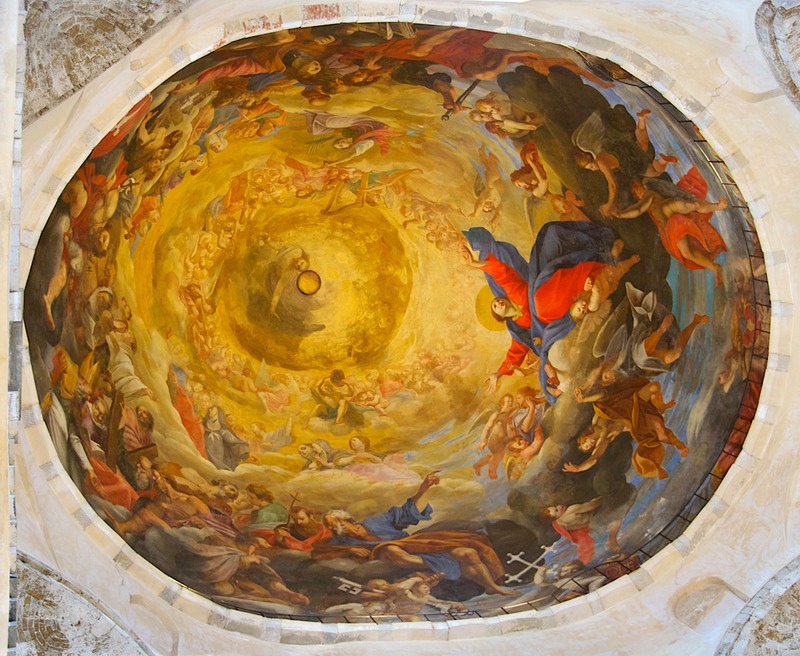
When we waved good-by to Pisa, we were headed for Bologna and the Ducati museum. We did a drive-by of Lucca, which looked interesting. But we’d kind of finished with hill towns for now, along with the crowds. The weather continued to be lovely as we traveled along country roads between enormous old plane trees that were planted by Napoleon to shade his troops as they marched along. (We think this was Napoleon’s real legacy in Europe.) We climbed up into the Apennines, past Abetone to the top of the pass at 4200 feet and 47℉; in the winter they ski here, but for now it was weekend getaway folks.
As we drove along, we talked about what we were and were not enjoying here in Italy. Positives: lovely countryside and charming small towns with interesting things to see; the friendly nature of the Italian people we had met. Negatives: going from one “set piece” touristy town to the next; the crowds; the feeling of being gouged on a regular basis – in part because we were in a tourist area and in part because we were in an RV; the sense of having a list of what we had to do; hurry-hurry because there was so much yet unseen.
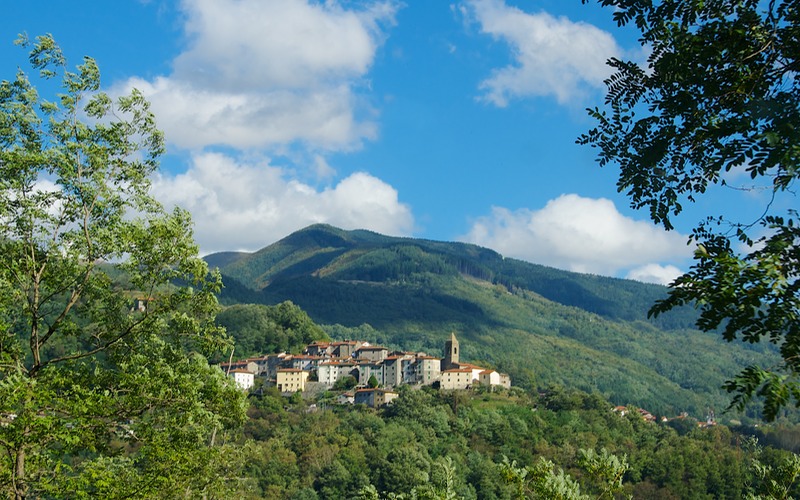
This is not the way we like to travel, and have done so very successfully for many years. We enjoy seeing what strikes our fancy, when we want to see it, unencumbered by so many other folks that there’s no clear view of the object at hand. We dislike being in an area where we are paying fancy money for something that was free a hundred miles away. Sticks in our craw!
So, along the way to Bologna, we changed our game plan. We began carefully picking among the offerings in the Art & Architecture world of Italy, combining those visits with more time in rural areas and visiting locations that sounded off the beaten track but still with considerable merit (if not art treasures), we suddenly felt much better about our remaining time here. We’d reached a Tipping Point, if you will, and all has been great ever since. Many of our friends would be horrified to hear we would not be visiting X, Y or Z. But we had turned a corner and were now embarking on Our Trip to Italy.
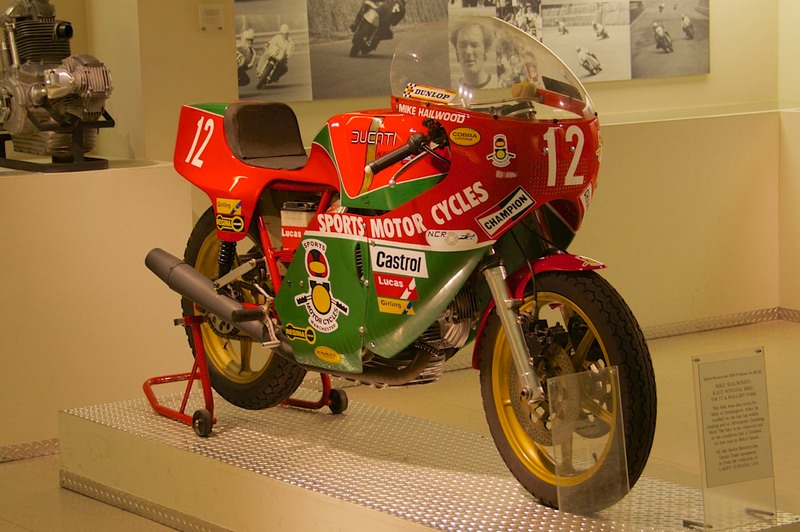
On to Bologna. The Ducati museum and factory tour was just great and Rick enjoyed it very much. First he took a tour of the clean and shining factory where Ducatis are assembled for export to most of the world, and then a guided tour of the wonderful museum. Bike museums are not generally as interesting and varied as car museums, at least in a purely visual sense, but Ducatis are among the most beautiful of all motorcycles and Red is such a nice color. One fascinating insight gained is that the latest race bikes are actually Orange in color because somehow HD TV alters the colors some and the Orange comes across as real Italian Racing Red on TV – what is our world coming to?
Later that day we started east, heading for Ravenna. We spent a night betwixt the two, at the ancient spa town of Castel San Pieto Terme (such an evocative name). It was a pretty town, and we were parked for the night under trees that had all turned a gorgeous yellow, next to community gardens planted with produce to be put up for the winter. Folks were out in the autumn sunshine, digging up greens and tomatoes and potatoes – and a few weeds. We felt right in the middle of “real” life.
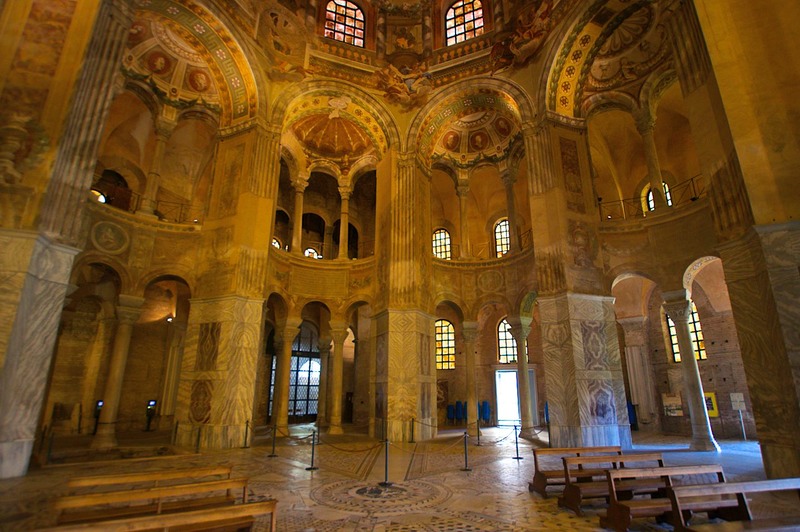
Driving on to Ravenna, we came out onto the huge Po River Delta, taking a zigzag route along quiet back roads, through vineyards, orchards and fields either bare or with crops being harvested. It reminded us of California’s Central Valley back 50-60 years ago.
Then we reached the Adriatic Sea, and Ravenna. Ravenna became capital of the Western Roman empire 1600 years ago. In the year 402, the Duke of Milan had moved his court there, thinking it would be more easily protected from invasion. About 75 years later, Ravenna was captured by the Goths. That could have been the end of the story, but the Goths, also Christians, continued the existing traditions. Shortly afterwards the city was annexed into the Easter Empire and the best of the adornments to the churches that we delight in today were created. Ravenna is really different due to its Byzantine roots; we almost felt as though we had returned to Turkey, and Ravenna quickly became one of our favorite places in Italy.
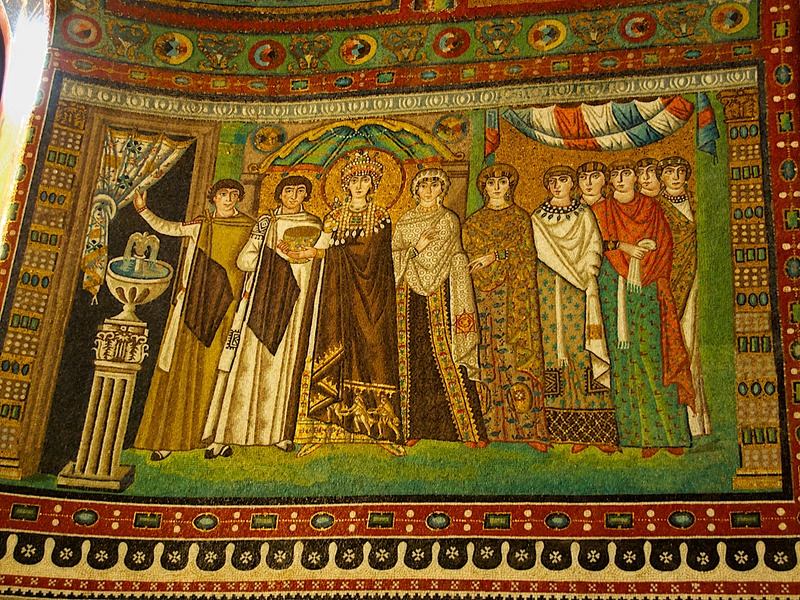
There are several UNESCO sites here, churches, mausoleums and the like; protected mostly because of their gorgeous, well preserved mosaics. They were stunning, and we’ve got the pictures to prove it! We spent two days wandering around, enjoying the historic structures and the rest of this extremely pleasant city. A super adventure. Ravenna is competing for European City of Culture for 2019; we think they’ve got a pretty good chance.
Leaving, we turned inland again. Arriving in Urbino (also competing for ECC for 2019), we started rubbing our hands with glee. What a great city! We started out feeling good because a woman who realized the bus we were waiting for, to take us up into the old city, would probably not come for a verrrrry long time, gave us a ride up to the top of the very steep hill. Arriving, we were delighted with our surroundings. Urbino is one of the really nice towns in this area. We wandered the renaissance squares, the medieval winding streets, and enjoyed the super city skyline.The Palazzo Ducale, a great piece of architecture and home of the dukes of Urbino for centuries, has been turned into a really good picture gallery, with some amazing Ucellos, Raphaelos and several Piero della Francesca goodies; it was a terrific visit.
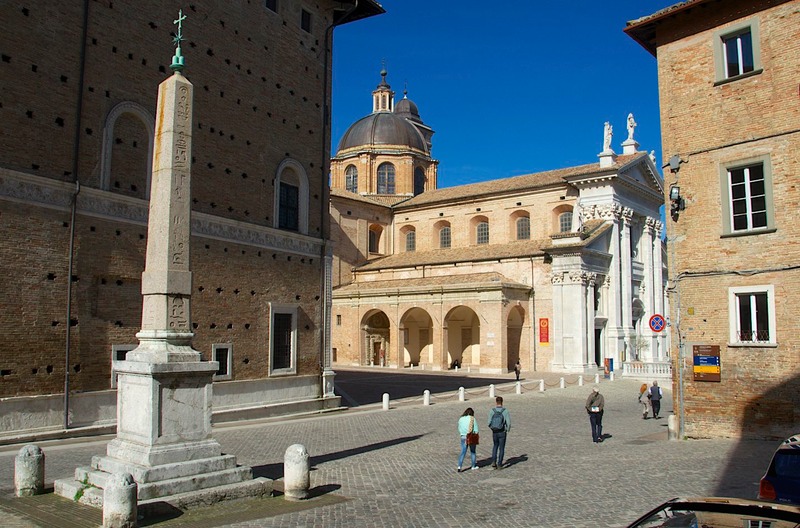
After a day of wandering, we finally found a bus we thought was heading down the hill toward our parking area. Well, yes it was. Well, no, it wasn’t particularly direct. Took quite awhile, but the upside was that we got to see a lot of the surrounding area as we dropped off folks, picked up a bunch of school kids heading home in the afternoon, and, after about an hour, ended up within sight of our spot. Bus driver decided it wasn’t really on his route, but we yelled and pulled cords and made it obvious we wanted out, and he finally pulled over for us. We trotted on down the rest of the hill, packed up, and hit the road.
Piero della Francesca is one of my favorite artists, and so we took ourselves over to Monterchi, a small village which has one of his best frescoes, the Madonna del Parto. It originally was on the wall of the local church, but it had been moved into a separate building and museum. It was spectacular. There was also an excellent film on della Francesca and the Florence/Umbrian area connection, which we enjoyed. Monterchi is a tiny place and that added to our enjoyment, as we spent about 20 minutes and took it in in its entirety. It was a lovely fall day, and the town’s trees were golden yellow in the soft light; could not have been more charming.
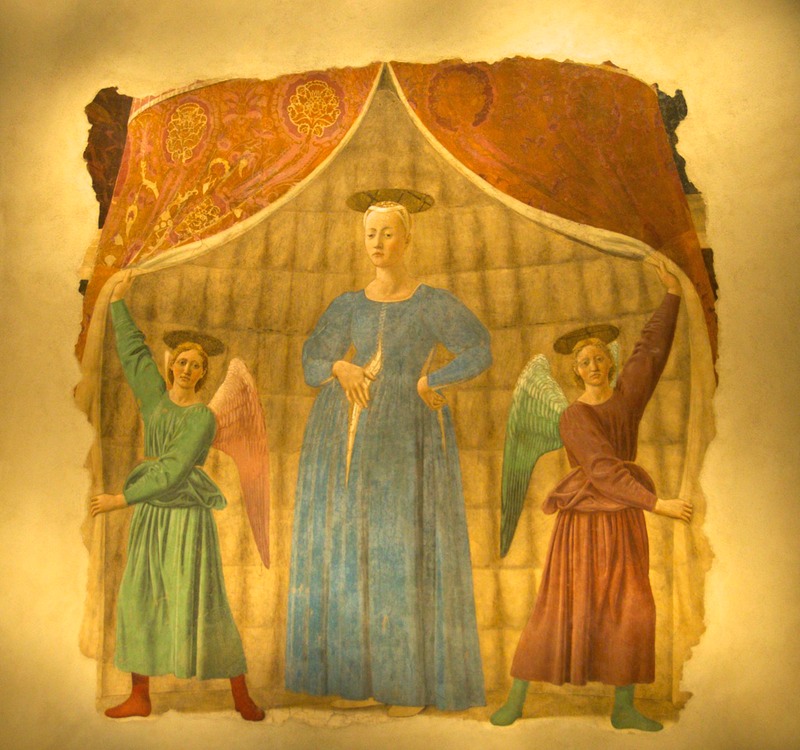
We finally tore ourselves away, and wandering the countryside we ended up back on the coast. We needed to go to Civitanova. The point of Civitanova was to find the local Chevy dealership, because we were looking for a place to get the Tiger serviced. When located, they were nice but not interested in our American beast. Disappointed but not deterred, we decided to keep moving toward Rome, knowing that somewhere along the way we’d find a dealer who would be willing to help us out. It’s an interesting problem; Chevrolet is a familiar name all over Europe, but not the vehicle we have. Therefore, unless they are interested enough to tackle something they’re not already familiar with they don’t want to do the work. We don’t always rely on Chevy dealers by any means, but in the absence of a recommendation from someone a dealer is usually our first choice.
Back inland, we continued to enjoy the hill towns, each with its high tower(s) and church plopped on top, every one of them picturesque. We stopped to visit the Abbadia Santa Marie a pié di Chienti, a 10th century piece of lovely architecture. It was a real treat. The Chienti Valley is quite pretty, but outlet stores and local development are starting to take a toll. But still we found new crops of oranges ripening on the trees, pomegranates everywhere, and other signs of a healthy economy.
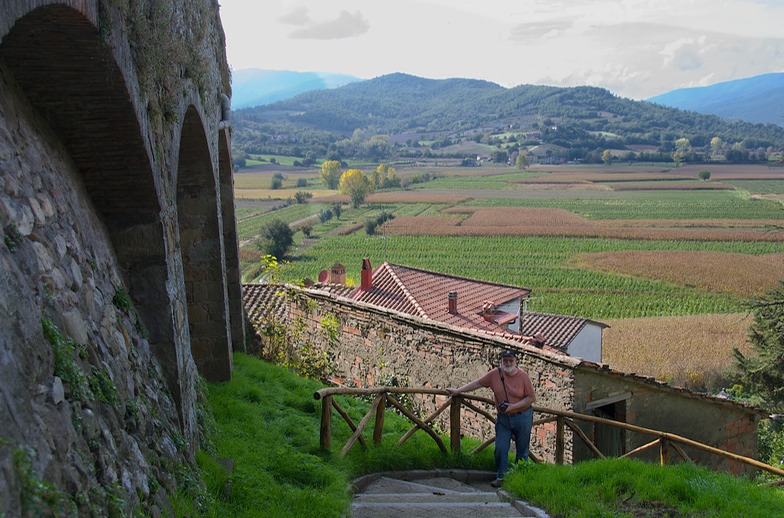
There are many abbeys in this area, each one interesting to visit. South of Macerata, following the Fiastra River we stopped to check out the Abbadia Fiastra. It would make a very pleasant retreat. Above the river we followed the ridgeline to San Ginesio. In the soft light there were lovely views out over the grapes and olive orchards. They are harvesting the olives now, using these cool, hand-held machines that shake the trees to release the olives, which fall onto the tarps below. We saw old ladies, young children, absolutely everyone getting involved. A lovely late fall day is a perfect time to be traveling in rural Italy, that’s for sure. In San Ginesio we met a delightful old guy with his cute old Fiat. I took his picture, and then he required me to climb into the car and stick myself out the roof while Rick took pictures of the two of us. A great moment. He was a hoot.
As you can see, we’d definitely found our Italian adventure. We continued making our way south and west, slowly moving toward Rome. Our path took us through parts of the Sibillini National Park. Now there’s a really different area! Most of Italy is green and golden, filled with orchards and fertile agriculture. Much of the park is very barren and alpine in nature, a lot like the steppes of eastern Turkey; well above tree level. It was a real change in scenery. We stopped for the night at a desolate pull off at about 3300 feet.
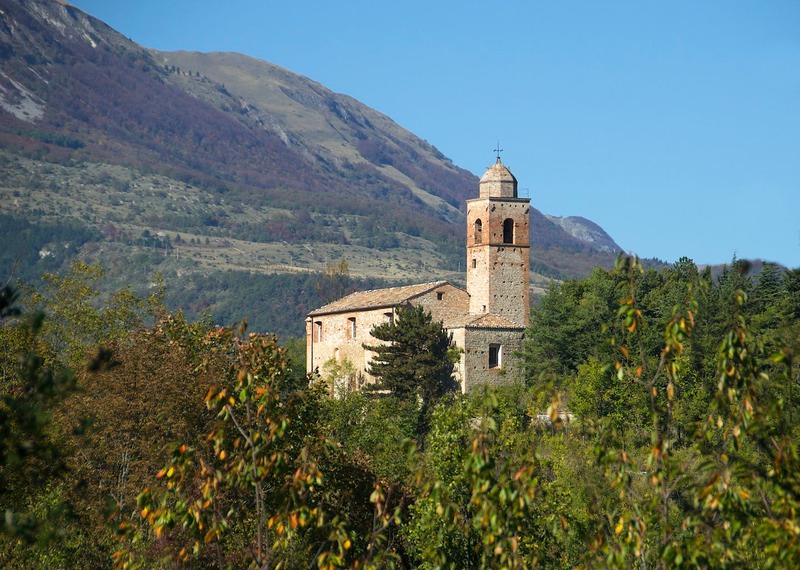
The next day we dropped down again, into an area of fish farms along a mountain stream, gorgeous in the morning mists. Back into the park again and up past the Abbadia di San Eutizio, best known for its production of castrati during the Renaissance (a dubious honor; but it was also known for the hospital there where they were famous for removing kidney stones…). Over a hill and then down into the lush valley where Norcia lies – home of the famous prosciutto and salami (I brought some home on the plane) products. It was Sunday and all the markets were open with their products laid out to try; it was a yummy visit and another nice town.
In the area near Valnerina we followed the Nera River through deep canyons, past villages hanging off cliffs. We wanted to visit the Abbadia di San Pietro in Valle, but it was closed for the winter so we just walked the grounds, taking pictures of the Tiger parked among the olive trees. It was a great area. Then we took this teensy, tiny road that Emily (our GPS) tried to warn us against (the Tiger did quite nicely, thank you) through the mountains near Spoleto, to Foligno and the Chevy dealer there. They took excellent care of us without batting an eye, the Tiger is now up to date on routine service appointments, and Foligno is a nice medium-sized town. It’s not on the tourist route, but it was quite pleasant, with a walled old town in the middle. Cool.
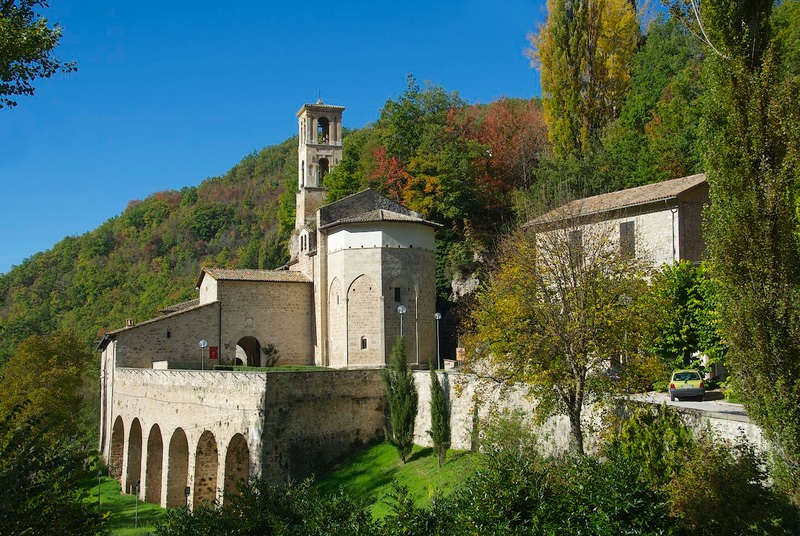
Leaving Foligno, we headed up into the hills above Spello, spending the night in the parking area for a retreat hanging off the hillside on the edge of Park Monte Subasio. The vineyards are now turning bright red. What great countryside!
We had several more little spots we wanted to visit before leaving Europe for the year, but we were beginning to run out of steam. And, we’d just made contact with a young Australian couple we’d been corresponding with for several months. They were going to be taking the ferry from Croatia to Ancona in a few days and coming close to where we were. Well! We’d just landed in a perfect spot, so we sat down for several days and waited for them. We were in the delightful small town of Bevagna, parked in one of the nicest sostas we’ve seen in Italy. It was in an open field on the edge of town, lined with trees, a quick 10-minute walk into the old center, with all the facilities we needed, and filled with sunshine. Oh, and a local olive processing plant nearby, complete with olive oil available for purchase. We were jazzed.
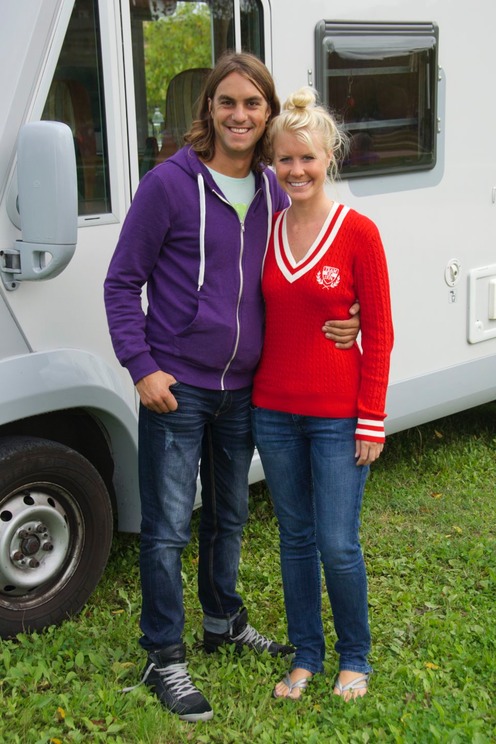
We stayed in Bevagna for most of a week. We worked on computer projects, cleaned up the coach in preparation for putting it into winter storage, walked into town for groceries and sight-seeing, and generally enjoyed ourselves hugely. The town has at least 3 churches, all with active bells; we really enjoyed listening to them tell the time and announce services. It was Halloween, then the Days of the Dead, with special services. Lots of bell ringing. A few days later we heard the bells being tuned, and (we think) a new bell ringer being trained. Time for a change.
Over the weekend, the quiet and empty sosta filled with 50-60 motorhomes of various sizes, in town to enjoy the local hazelnut (nocciola) harvest festival and to cycle the pretty surrounding countryside.They were a real hoot and we all enjoyed getting to know one another. Large numbers of them went off on bike rides each day with much laughing and waving of flags. At the end of the weekend they all disappeared and we had the place to ourselves again.
Monday afternoon our young Australian friends Kate & George arrived. We crammed in about 24 delightful hours with them -- actually meeting them for the first time as we’d been email friends until now – before they headed out to continue their adventures and we resumed our path to Rome. It was a wonderful time we had together, and we really hope to meet up with them again.
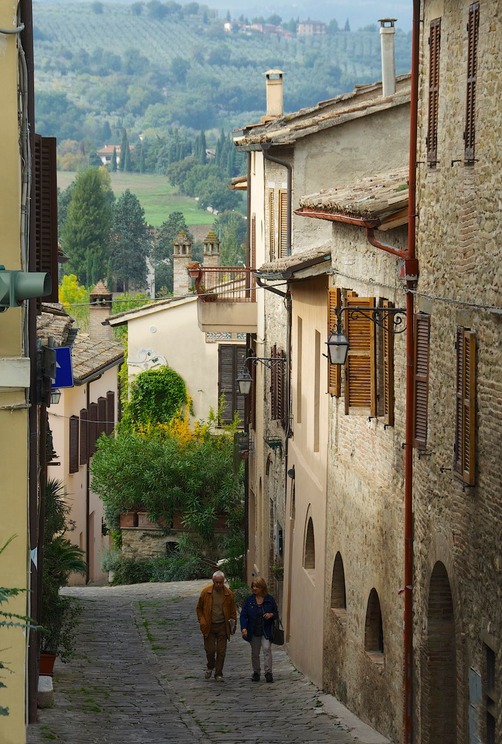
On Friday morning we were flying back to the States. So this is how all that worked out. Wednesday morning we drove to Civita Castellana, a city about 90 minutes from the airport. We spent the night there, and then emptied our tanks for the winter and drove towards the airport outside Rome.
We’d made arrangements to store the Tiger in a long-term storage lot close to the airport. We came in late Thursday afternoon and they had a terrific place ready for us – a grassy field close to the office in a secure lot with dogs and lights at night, a free shuttle to the airport whenever we needed it – and it was just fine with them for us to spend Thursday night in the coach. This may not seem like heaven to you (to each his own, of course!) but we were tickled pink. Everything went smooth as silk, and the next morning we began a long day flying from Rome to Houston by way of London. About 28 hours later, we disembarked to a friendly “Howdy, y’all!” … back in Texas once again.
We’re getting used to being back in the States – the roads are wide and lovely, Rick’s favorite foods are around every corner, and traveling in our State-side, larger motorhome has distinct advantages. We miss the Tiger, of course, but we’ll be back in Italy come March, heading out for new adventures. If you are anywhere near our winter path we’ll hope to see you in the coming months. If you are in Europe, let’s try and get together in 2014!
Ciao for now, Rick and Kathy and their American entourage – the Foretravel, the bike, and the car – movin’ on down the road.
Click to see more photos from Tuscany, Umbria & Marche